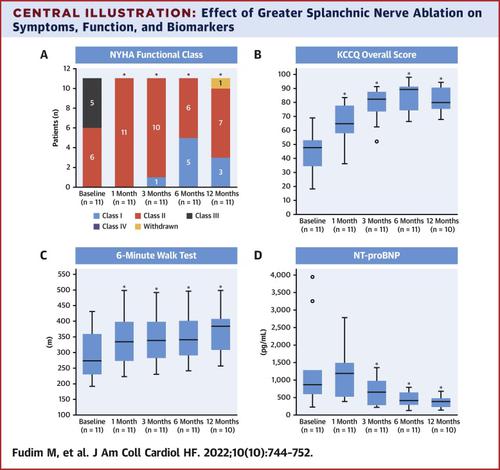JACC: Heart Failure ( IF 10.3 ) Pub Date : 2022-07-06 , DOI: 10.1016/j.jchf.2022.05.009 Marat Fudim 1 , Teona Zirakashvili 2 , Nikoloz Shaburishvili 2 , Giorgi Shaishmelashvili 2 , Horst Sievert 3 , Kolja Sievert 3 , Vivek Y Reddy 4 , Zoar J Engelman 5 , Daniel Burkhoff 6 , Tamaz Shaburishvili 2 , Sanjiv J Shah 7

|
Background
Ablation of the right-sided greater splanchnic nerve (GSN) can reduce excessive splanchnic vasoconstriction, potentially improving the handling of volume shifts in patients with heart failure with preserved ejection fraction (HFpEF).
Objectives
The purpose of this study was to assess a novel catheter procedure of right-sided GSN ablation to treat HFpEF: splanchnic ablation for volume management.
Methods
This trial included 11 HFpEF patients (8 women, age 70 ± 8 years) with New York Heart Association functional class II or III symptoms, ejection fraction ≥50%, and elevated pulmonary capillary wedge pressure at rest or with exercise. After splanchnic ablation for volume management, follow-up at 1, 3, 6, and 12 months included 6-minute walk test, Kansas City Cardiomyopathy Questionnaire (KCCQ), and echocardiography.
Results
There were no device-related adverse cardiac events or clinical sequelae following right GSN ablation through 12 months. Patients experienced clinical improvements by 1 month that were sustained through 12 months. KCCQ score improved from baseline median 48 (IQR: 35-52) to 65 (IQR: 58-77) at 1 month and 80 (IQR: 77-88) at 12 months (P < 0.05). The 6-minute walk test distance increased from baseline 292 ± 82 m to 341 ± 88 m at 1 month and 359 ± 75 m at 12 months (P < 0.05). The NT-proBNP decreased from a baseline mean of 1,292 ± 1,186 pg/mL to 1,202 ± 797 pg/mL (P = 0.585) at 1 month, to 472 ± 226 pg/mL (P = 0.028) at 6 months, and to 379 ± 165 pg/mL (P = 0.039) at 12 months.
Conclusions
In this open-label, single-arm feasibility study, right-sided GSN ablation was safe and improved mostly subjective clinical metrics in patients with HFpEF over 12 months. (Endovascular GSN Ablation in Subjects With HFpEF; NCT04287946)
中文翻译:

经静脉右内脏大神经消融治疗心力衰竭和保留射血分数
背景
右侧内脏大神经 (GSN) 的消融可以减少过度的内脏血管收缩,可能改善射血分数保留的心力衰竭 (HFpEF) 患者对容量变化的处理。
目标
本研究的目的是评估一种用于治疗 HFpEF 的新型右侧 GSN 消融导管手术:用于体积管理的内脏消融。
方法
该试验包括 11 名 HFpEF 患者(8 名女性,年龄 70 ± 8 岁),他们有纽约心脏协会功能分级 II 级或 III 级症状、射血分数≥50%,以及静息或运动时肺毛细血管楔压升高。进行容量管理的内脏消融后,第 1、3、6 和 12 个月的随访包括 6 分钟步行试验、堪萨斯城心肌病问卷 (KCCQ) 和超声心动图。
结果
右侧 GSN 消融后 12 个月没有发生与器械相关的不良心脏事件或临床后遗症。患者在 1 个月内经历了持续 12 个月的临床改善。KCCQ 评分从基线中位数 48 (IQR:35-52) 提高到 1 个月时的 65 (IQR:58-77) 和 12 个月时的 80 (IQR:77-88) ( P < 0.05)。6 分钟步行测试距离从基线 292 ± 82 m 增加到 1 个月时的 341 ± 88 m 和 12 个月时的 359 ± 75 m ( P < 0.05)。NT-proBNP 在 1 个月时从基线平均值 1,292 ± 1,186 pg/mL 降至 1,202 ± 797 pg/mL ( P = 0.585),在 6 个月时降至 472 ± 226 pg/mL ( P = 0.028),并12 个月时为379 ± 165 pg/mL ( P = 0.039)。
结论
在这项开放标签、单臂可行性研究中,右侧 GSN 消融是安全的,并且改善了超过 12 个月的 HFpEF 患者的主要主观临床指标。(HFpEF 患者的血管内 GSN 消融术;NCT04287946)











































 京公网安备 11010802027423号
京公网安备 11010802027423号